Values, Ethics, Collaborative Working in Business Environment Report
VerifiedAdded on 2022/12/15
|13
|4369
|180
Report
AI Summary
This report delves into the multifaceted aspects of workplace ethics, commencing with a foundational understanding of ethics and the factors that influence it within a business context. It emphasizes the significance of ethical conduct in fostering business growth and success, while also exploring relevant UK laws that promote ethical practices. The report analyzes corporate social responsibility (CSR) through the example of Starbucks, highlighting its initiatives and impact. Furthermore, it outlines essential rules for employees and examines the legal rights afforded by the General Data Protection Regulation (GDPR). The report also elaborates on collaborative working, outlining its strategies, associated values, required interpersonal skills, benefits, and the promotion of equality and diversity in the workplace, including the integration of British values. Finally, it addresses the potential consequences of poor collaborative working.
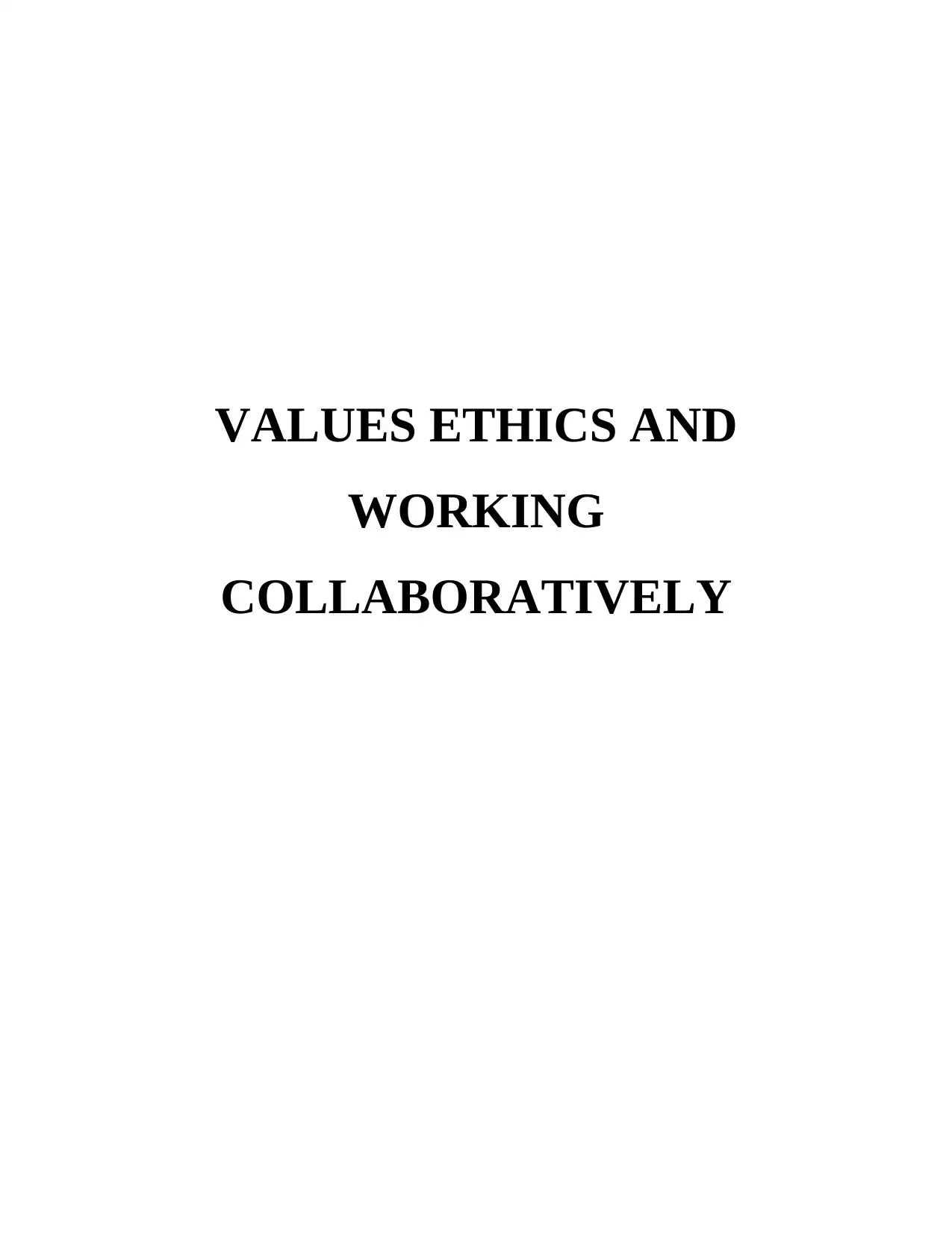
VALUES ETHICS AND
WORKING
COLLABORATIVELY
WORKING
COLLABORATIVELY
Paraphrase This Document
Need a fresh take? Get an instant paraphrase of this document with our AI Paraphraser
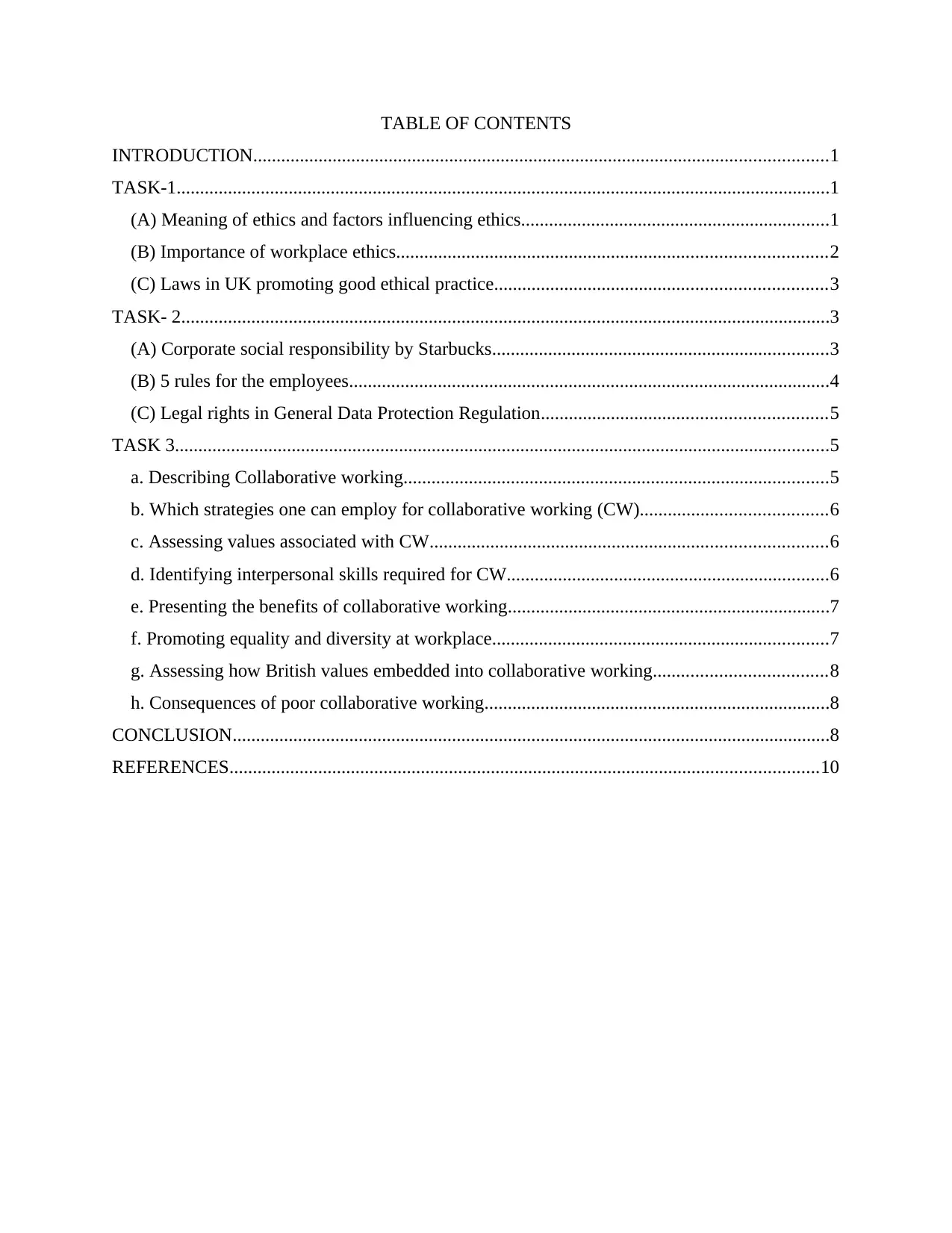
TABLE OF CONTENTS
INTRODUCTION...........................................................................................................................1
TASK-1............................................................................................................................................1
(A) Meaning of ethics and factors influencing ethics..................................................................1
(B) Importance of workplace ethics............................................................................................2
(C) Laws in UK promoting good ethical practice.......................................................................3
TASK- 2...........................................................................................................................................3
(A) Corporate social responsibility by Starbucks........................................................................3
(B) 5 rules for the employees.......................................................................................................4
(C) Legal rights in General Data Protection Regulation.............................................................5
TASK 3............................................................................................................................................5
a. Describing Collaborative working...........................................................................................5
b. Which strategies one can employ for collaborative working (CW)........................................6
c. Assessing values associated with CW.....................................................................................6
d. Identifying interpersonal skills required for CW.....................................................................6
e. Presenting the benefits of collaborative working.....................................................................7
f. Promoting equality and diversity at workplace........................................................................7
g. Assessing how British values embedded into collaborative working.....................................8
h. Consequences of poor collaborative working..........................................................................8
CONCLUSION................................................................................................................................8
REFERENCES..............................................................................................................................10
INTRODUCTION...........................................................................................................................1
TASK-1............................................................................................................................................1
(A) Meaning of ethics and factors influencing ethics..................................................................1
(B) Importance of workplace ethics............................................................................................2
(C) Laws in UK promoting good ethical practice.......................................................................3
TASK- 2...........................................................................................................................................3
(A) Corporate social responsibility by Starbucks........................................................................3
(B) 5 rules for the employees.......................................................................................................4
(C) Legal rights in General Data Protection Regulation.............................................................5
TASK 3............................................................................................................................................5
a. Describing Collaborative working...........................................................................................5
b. Which strategies one can employ for collaborative working (CW)........................................6
c. Assessing values associated with CW.....................................................................................6
d. Identifying interpersonal skills required for CW.....................................................................6
e. Presenting the benefits of collaborative working.....................................................................7
f. Promoting equality and diversity at workplace........................................................................7
g. Assessing how British values embedded into collaborative working.....................................8
h. Consequences of poor collaborative working..........................................................................8
CONCLUSION................................................................................................................................8
REFERENCES..............................................................................................................................10
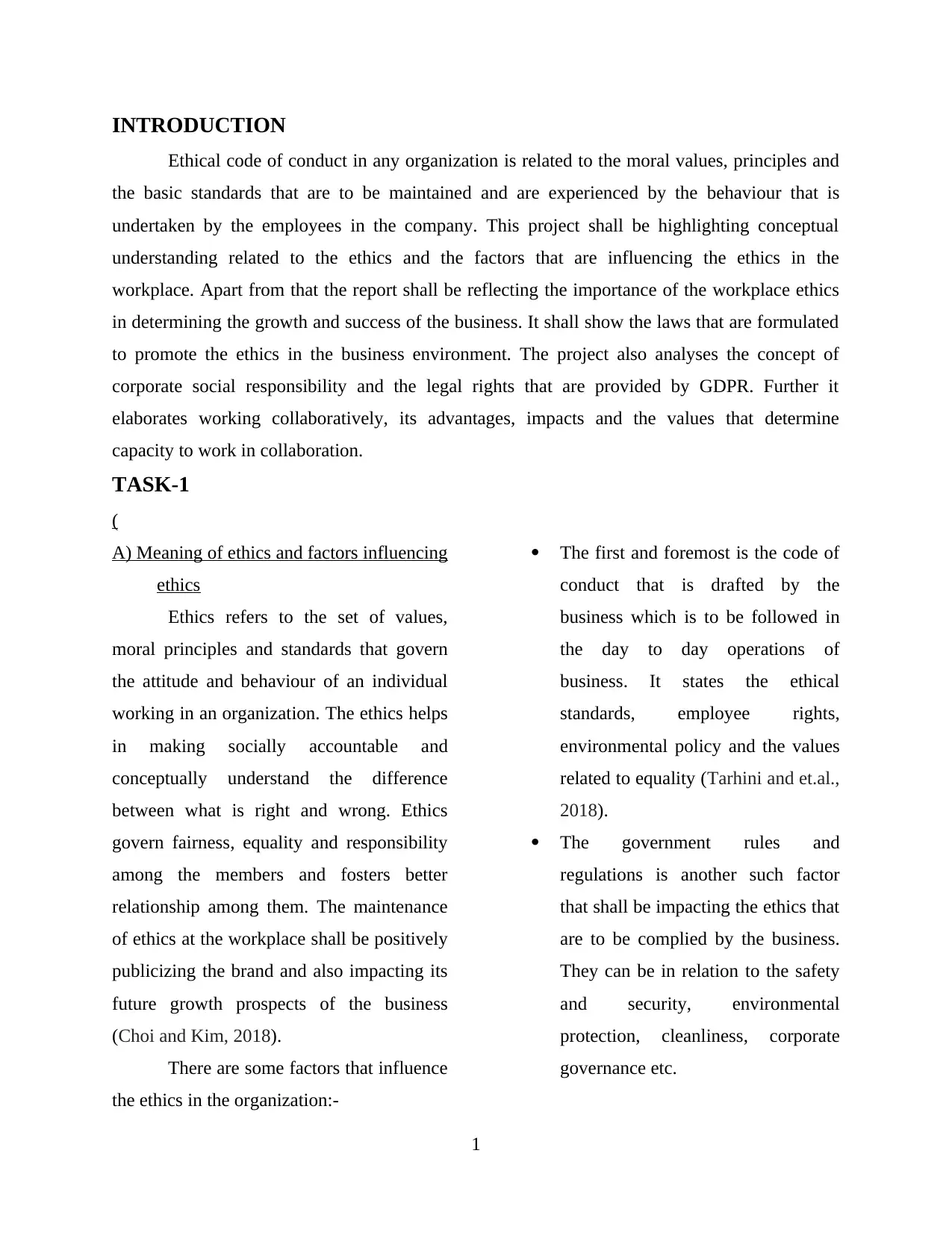
INTRODUCTION
Ethical code of conduct in any organization is related to the moral values, principles and
the basic standards that are to be maintained and are experienced by the behaviour that is
undertaken by the employees in the company. This project shall be highlighting conceptual
understanding related to the ethics and the factors that are influencing the ethics in the
workplace. Apart from that the report shall be reflecting the importance of the workplace ethics
in determining the growth and success of the business. It shall show the laws that are formulated
to promote the ethics in the business environment. The project also analyses the concept of
corporate social responsibility and the legal rights that are provided by GDPR. Further it
elaborates working collaboratively, its advantages, impacts and the values that determine
capacity to work in collaboration.
TASK-1
(
A) Meaning of ethics and factors influencing
ethics
Ethics refers to the set of values,
moral principles and standards that govern
the attitude and behaviour of an individual
working in an organization. The ethics helps
in making socially accountable and
conceptually understand the difference
between what is right and wrong. Ethics
govern fairness, equality and responsibility
among the members and fosters better
relationship among them. The maintenance
of ethics at the workplace shall be positively
publicizing the brand and also impacting its
future growth prospects of the business
(Choi and Kim, 2018).
There are some factors that influence
the ethics in the organization:-
The first and foremost is the code of
conduct that is drafted by the
business which is to be followed in
the day to day operations of
business. It states the ethical
standards, employee rights,
environmental policy and the values
related to equality (Tarhini and et.al.,
2018).
The government rules and
regulations is another such factor
that shall be impacting the ethics that
are to be complied by the business.
They can be in relation to the safety
and security, environmental
protection, cleanliness, corporate
governance etc.
1
Ethical code of conduct in any organization is related to the moral values, principles and
the basic standards that are to be maintained and are experienced by the behaviour that is
undertaken by the employees in the company. This project shall be highlighting conceptual
understanding related to the ethics and the factors that are influencing the ethics in the
workplace. Apart from that the report shall be reflecting the importance of the workplace ethics
in determining the growth and success of the business. It shall show the laws that are formulated
to promote the ethics in the business environment. The project also analyses the concept of
corporate social responsibility and the legal rights that are provided by GDPR. Further it
elaborates working collaboratively, its advantages, impacts and the values that determine
capacity to work in collaboration.
TASK-1
(
A) Meaning of ethics and factors influencing
ethics
Ethics refers to the set of values,
moral principles and standards that govern
the attitude and behaviour of an individual
working in an organization. The ethics helps
in making socially accountable and
conceptually understand the difference
between what is right and wrong. Ethics
govern fairness, equality and responsibility
among the members and fosters better
relationship among them. The maintenance
of ethics at the workplace shall be positively
publicizing the brand and also impacting its
future growth prospects of the business
(Choi and Kim, 2018).
There are some factors that influence
the ethics in the organization:-
The first and foremost is the code of
conduct that is drafted by the
business which is to be followed in
the day to day operations of
business. It states the ethical
standards, employee rights,
environmental policy and the values
related to equality (Tarhini and et.al.,
2018).
The government rules and
regulations is another such factor
that shall be impacting the ethics that
are to be complied by the business.
They can be in relation to the safety
and security, environmental
protection, cleanliness, corporate
governance etc.
1
⊘ This is a preview!⊘
Do you want full access?
Subscribe today to unlock all pages.

Trusted by 1+ million students worldwide
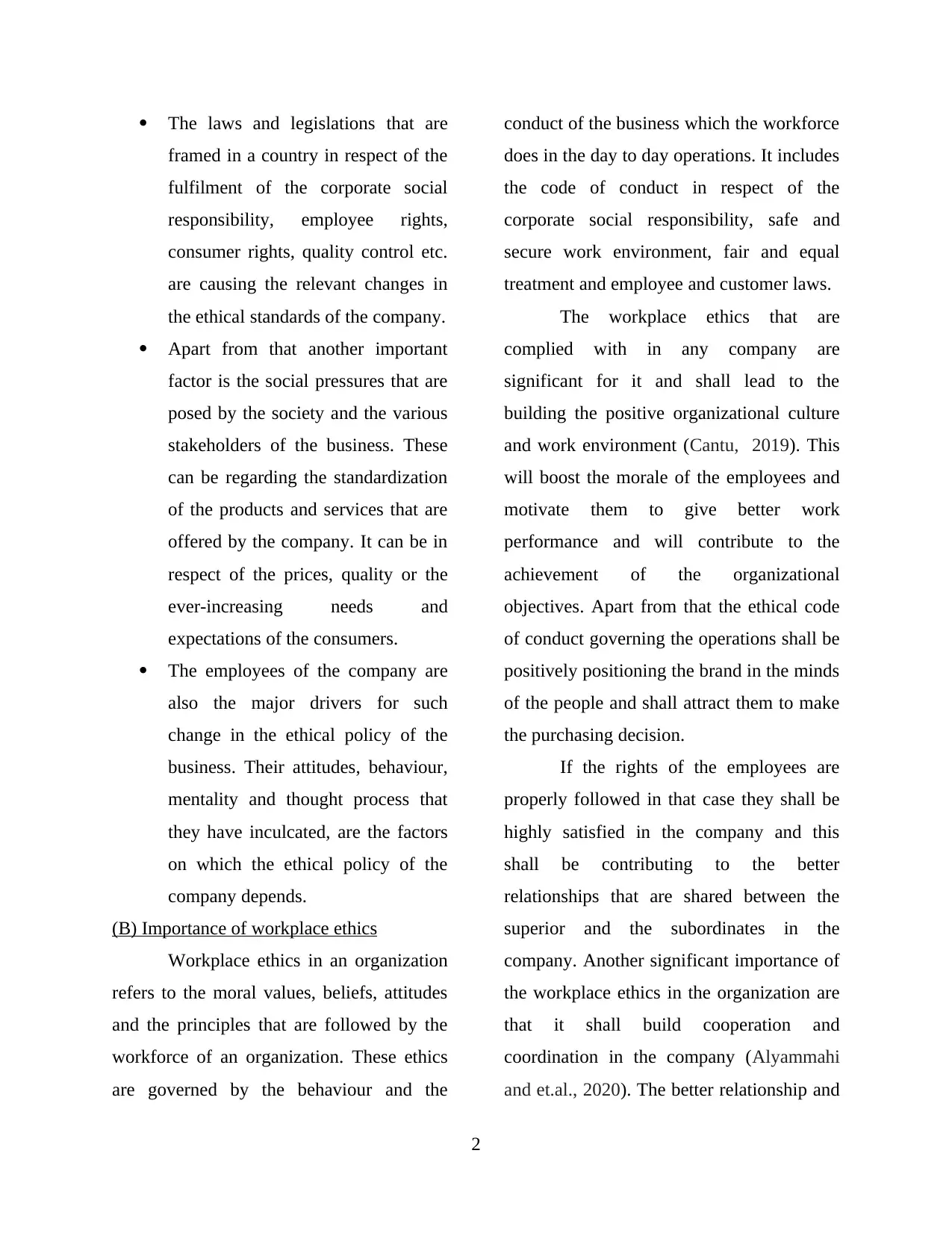
The laws and legislations that are
framed in a country in respect of the
fulfilment of the corporate social
responsibility, employee rights,
consumer rights, quality control etc.
are causing the relevant changes in
the ethical standards of the company.
Apart from that another important
factor is the social pressures that are
posed by the society and the various
stakeholders of the business. These
can be regarding the standardization
of the products and services that are
offered by the company. It can be in
respect of the prices, quality or the
ever-increasing needs and
expectations of the consumers.
The employees of the company are
also the major drivers for such
change in the ethical policy of the
business. Their attitudes, behaviour,
mentality and thought process that
they have inculcated, are the factors
on which the ethical policy of the
company depends.
(B) Importance of workplace ethics
Workplace ethics in an organization
refers to the moral values, beliefs, attitudes
and the principles that are followed by the
workforce of an organization. These ethics
are governed by the behaviour and the
conduct of the business which the workforce
does in the day to day operations. It includes
the code of conduct in respect of the
corporate social responsibility, safe and
secure work environment, fair and equal
treatment and employee and customer laws.
The workplace ethics that are
complied with in any company are
significant for it and shall lead to the
building the positive organizational culture
and work environment (Cantu, 2019). This
will boost the morale of the employees and
motivate them to give better work
performance and will contribute to the
achievement of the organizational
objectives. Apart from that the ethical code
of conduct governing the operations shall be
positively positioning the brand in the minds
of the people and shall attract them to make
the purchasing decision.
If the rights of the employees are
properly followed in that case they shall be
highly satisfied in the company and this
shall be contributing to the better
relationships that are shared between the
superior and the subordinates in the
company. Another significant importance of
the workplace ethics in the organization are
that it shall build cooperation and
coordination in the company (Alyammahi
and et.al., 2020). The better relationship and
2
framed in a country in respect of the
fulfilment of the corporate social
responsibility, employee rights,
consumer rights, quality control etc.
are causing the relevant changes in
the ethical standards of the company.
Apart from that another important
factor is the social pressures that are
posed by the society and the various
stakeholders of the business. These
can be regarding the standardization
of the products and services that are
offered by the company. It can be in
respect of the prices, quality or the
ever-increasing needs and
expectations of the consumers.
The employees of the company are
also the major drivers for such
change in the ethical policy of the
business. Their attitudes, behaviour,
mentality and thought process that
they have inculcated, are the factors
on which the ethical policy of the
company depends.
(B) Importance of workplace ethics
Workplace ethics in an organization
refers to the moral values, beliefs, attitudes
and the principles that are followed by the
workforce of an organization. These ethics
are governed by the behaviour and the
conduct of the business which the workforce
does in the day to day operations. It includes
the code of conduct in respect of the
corporate social responsibility, safe and
secure work environment, fair and equal
treatment and employee and customer laws.
The workplace ethics that are
complied with in any company are
significant for it and shall lead to the
building the positive organizational culture
and work environment (Cantu, 2019). This
will boost the morale of the employees and
motivate them to give better work
performance and will contribute to the
achievement of the organizational
objectives. Apart from that the ethical code
of conduct governing the operations shall be
positively positioning the brand in the minds
of the people and shall attract them to make
the purchasing decision.
If the rights of the employees are
properly followed in that case they shall be
highly satisfied in the company and this
shall be contributing to the better
relationships that are shared between the
superior and the subordinates in the
company. Another significant importance of
the workplace ethics in the organization are
that it shall build cooperation and
coordination in the company (Alyammahi
and et.al., 2020). The better relationship and
2
Paraphrase This Document
Need a fresh take? Get an instant paraphrase of this document with our AI Paraphraser
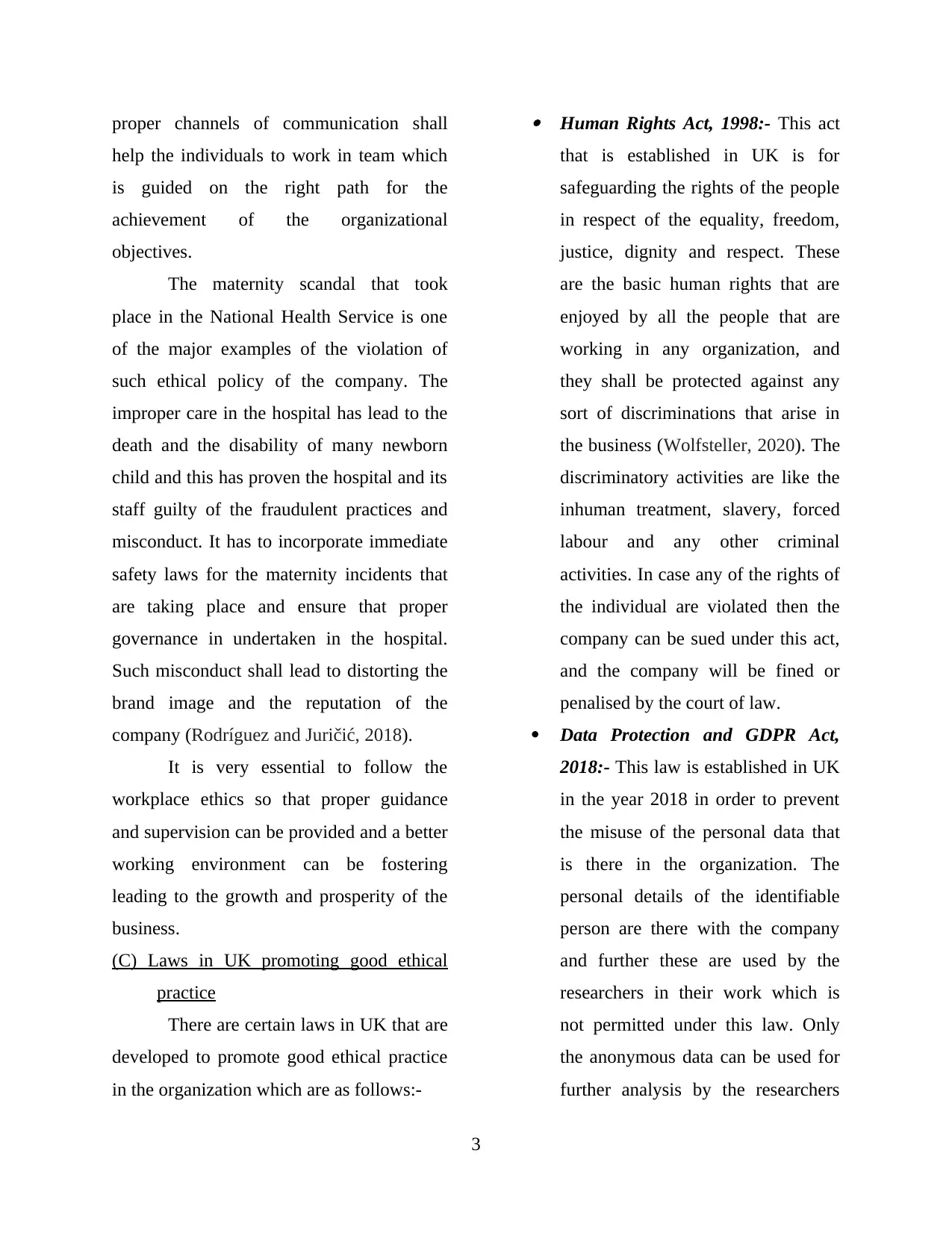
proper channels of communication shall
help the individuals to work in team which
is guided on the right path for the
achievement of the organizational
objectives.
The maternity scandal that took
place in the National Health Service is one
of the major examples of the violation of
such ethical policy of the company. The
improper care in the hospital has lead to the
death and the disability of many newborn
child and this has proven the hospital and its
staff guilty of the fraudulent practices and
misconduct. It has to incorporate immediate
safety laws for the maternity incidents that
are taking place and ensure that proper
governance in undertaken in the hospital.
Such misconduct shall lead to distorting the
brand image and the reputation of the
company (Rodríguez and Juričić, 2018).
It is very essential to follow the
workplace ethics so that proper guidance
and supervision can be provided and a better
working environment can be fostering
leading to the growth and prosperity of the
business.
(C) Laws in UK promoting good ethical
practice
There are certain laws in UK that are
developed to promote good ethical practice
in the organization which are as follows:-
Human Rights Act, 1998:- This act
that is established in UK is for
safeguarding the rights of the people
in respect of the equality, freedom,
justice, dignity and respect. These
are the basic human rights that are
enjoyed by all the people that are
working in any organization, and
they shall be protected against any
sort of discriminations that arise in
the business (Wolfsteller, 2020). The
discriminatory activities are like the
inhuman treatment, slavery, forced
labour and any other criminal
activities. In case any of the rights of
the individual are violated then the
company can be sued under this act,
and the company will be fined or
penalised by the court of law.
Data Protection and GDPR Act,
2018:- This law is established in UK
in the year 2018 in order to prevent
the misuse of the personal data that
is there in the organization. The
personal details of the identifiable
person are there with the company
and further these are used by the
researchers in their work which is
not permitted under this law. Only
the anonymous data can be used for
further analysis by the researchers
3
help the individuals to work in team which
is guided on the right path for the
achievement of the organizational
objectives.
The maternity scandal that took
place in the National Health Service is one
of the major examples of the violation of
such ethical policy of the company. The
improper care in the hospital has lead to the
death and the disability of many newborn
child and this has proven the hospital and its
staff guilty of the fraudulent practices and
misconduct. It has to incorporate immediate
safety laws for the maternity incidents that
are taking place and ensure that proper
governance in undertaken in the hospital.
Such misconduct shall lead to distorting the
brand image and the reputation of the
company (Rodríguez and Juričić, 2018).
It is very essential to follow the
workplace ethics so that proper guidance
and supervision can be provided and a better
working environment can be fostering
leading to the growth and prosperity of the
business.
(C) Laws in UK promoting good ethical
practice
There are certain laws in UK that are
developed to promote good ethical practice
in the organization which are as follows:-
Human Rights Act, 1998:- This act
that is established in UK is for
safeguarding the rights of the people
in respect of the equality, freedom,
justice, dignity and respect. These
are the basic human rights that are
enjoyed by all the people that are
working in any organization, and
they shall be protected against any
sort of discriminations that arise in
the business (Wolfsteller, 2020). The
discriminatory activities are like the
inhuman treatment, slavery, forced
labour and any other criminal
activities. In case any of the rights of
the individual are violated then the
company can be sued under this act,
and the company will be fined or
penalised by the court of law.
Data Protection and GDPR Act,
2018:- This law is established in UK
in the year 2018 in order to prevent
the misuse of the personal data that
is there in the organization. The
personal details of the identifiable
person are there with the company
and further these are used by the
researchers in their work which is
not permitted under this law. Only
the anonymous data can be used for
further analysis by the researchers
3
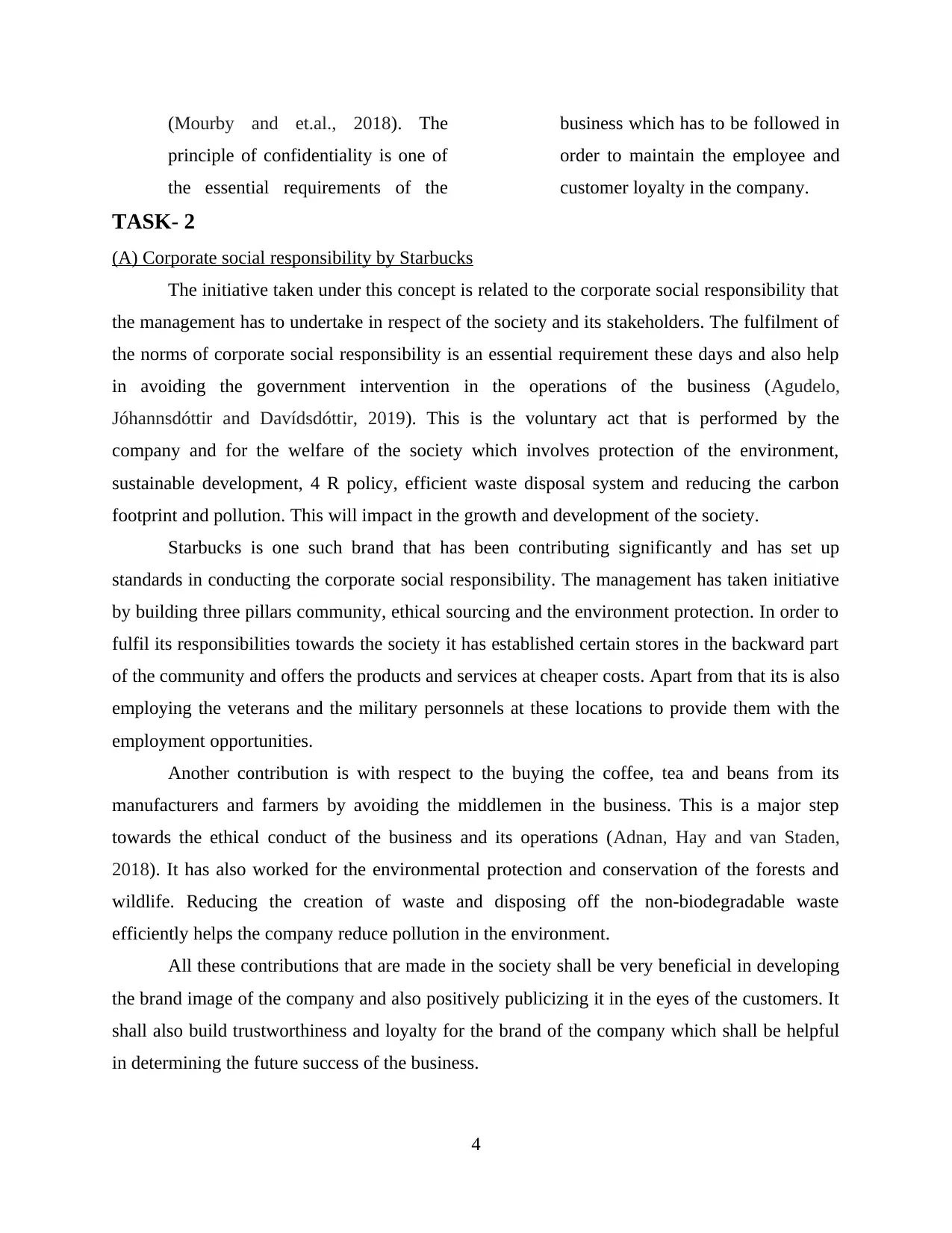
(Mourby and et.al., 2018). The
principle of confidentiality is one of
the essential requirements of the
business which has to be followed in
order to maintain the employee and
customer loyalty in the company.
TASK- 2
(A) Corporate social responsibility by Starbucks
The initiative taken under this concept is related to the corporate social responsibility that
the management has to undertake in respect of the society and its stakeholders. The fulfilment of
the norms of corporate social responsibility is an essential requirement these days and also help
in avoiding the government intervention in the operations of the business (Agudelo,
Jóhannsdóttir and Davídsdóttir, 2019). This is the voluntary act that is performed by the
company and for the welfare of the society which involves protection of the environment,
sustainable development, 4 R policy, efficient waste disposal system and reducing the carbon
footprint and pollution. This will impact in the growth and development of the society.
Starbucks is one such brand that has been contributing significantly and has set up
standards in conducting the corporate social responsibility. The management has taken initiative
by building three pillars community, ethical sourcing and the environment protection. In order to
fulfil its responsibilities towards the society it has established certain stores in the backward part
of the community and offers the products and services at cheaper costs. Apart from that its is also
employing the veterans and the military personnels at these locations to provide them with the
employment opportunities.
Another contribution is with respect to the buying the coffee, tea and beans from its
manufacturers and farmers by avoiding the middlemen in the business. This is a major step
towards the ethical conduct of the business and its operations (Adnan, Hay and van Staden,
2018). It has also worked for the environmental protection and conservation of the forests and
wildlife. Reducing the creation of waste and disposing off the non-biodegradable waste
efficiently helps the company reduce pollution in the environment.
All these contributions that are made in the society shall be very beneficial in developing
the brand image of the company and also positively publicizing it in the eyes of the customers. It
shall also build trustworthiness and loyalty for the brand of the company which shall be helpful
in determining the future success of the business.
4
principle of confidentiality is one of
the essential requirements of the
business which has to be followed in
order to maintain the employee and
customer loyalty in the company.
TASK- 2
(A) Corporate social responsibility by Starbucks
The initiative taken under this concept is related to the corporate social responsibility that
the management has to undertake in respect of the society and its stakeholders. The fulfilment of
the norms of corporate social responsibility is an essential requirement these days and also help
in avoiding the government intervention in the operations of the business (Agudelo,
Jóhannsdóttir and Davídsdóttir, 2019). This is the voluntary act that is performed by the
company and for the welfare of the society which involves protection of the environment,
sustainable development, 4 R policy, efficient waste disposal system and reducing the carbon
footprint and pollution. This will impact in the growth and development of the society.
Starbucks is one such brand that has been contributing significantly and has set up
standards in conducting the corporate social responsibility. The management has taken initiative
by building three pillars community, ethical sourcing and the environment protection. In order to
fulfil its responsibilities towards the society it has established certain stores in the backward part
of the community and offers the products and services at cheaper costs. Apart from that its is also
employing the veterans and the military personnels at these locations to provide them with the
employment opportunities.
Another contribution is with respect to the buying the coffee, tea and beans from its
manufacturers and farmers by avoiding the middlemen in the business. This is a major step
towards the ethical conduct of the business and its operations (Adnan, Hay and van Staden,
2018). It has also worked for the environmental protection and conservation of the forests and
wildlife. Reducing the creation of waste and disposing off the non-biodegradable waste
efficiently helps the company reduce pollution in the environment.
All these contributions that are made in the society shall be very beneficial in developing
the brand image of the company and also positively publicizing it in the eyes of the customers. It
shall also build trustworthiness and loyalty for the brand of the company which shall be helpful
in determining the future success of the business.
4
⊘ This is a preview!⊘
Do you want full access?
Subscribe today to unlock all pages.

Trusted by 1+ million students worldwide
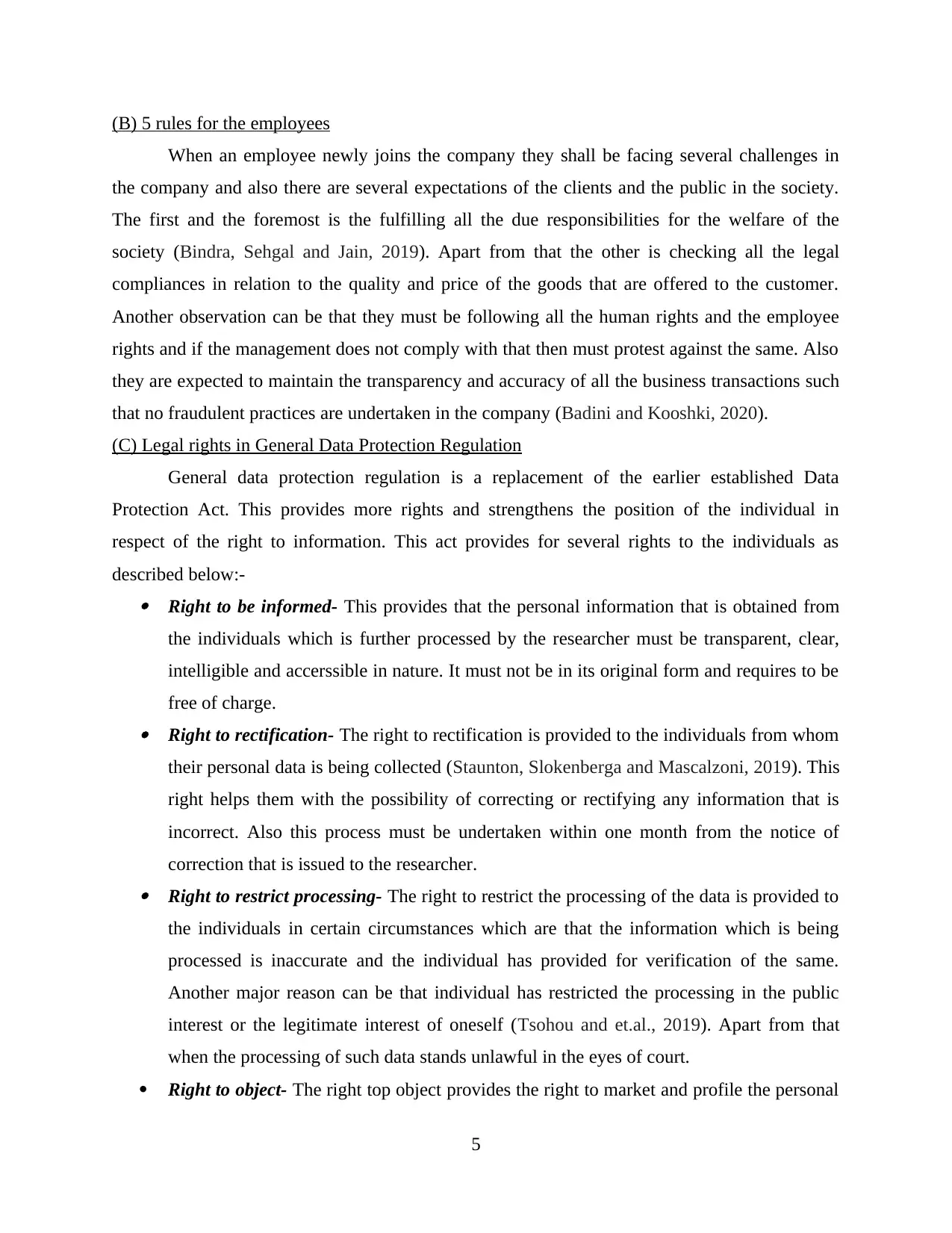
(B) 5 rules for the employees
When an employee newly joins the company they shall be facing several challenges in
the company and also there are several expectations of the clients and the public in the society.
The first and the foremost is the fulfilling all the due responsibilities for the welfare of the
society (Bindra, Sehgal and Jain, 2019). Apart from that the other is checking all the legal
compliances in relation to the quality and price of the goods that are offered to the customer.
Another observation can be that they must be following all the human rights and the employee
rights and if the management does not comply with that then must protest against the same. Also
they are expected to maintain the transparency and accuracy of all the business transactions such
that no fraudulent practices are undertaken in the company (Badini and Kooshki, 2020).
(C) Legal rights in General Data Protection Regulation
General data protection regulation is a replacement of the earlier established Data
Protection Act. This provides more rights and strengthens the position of the individual in
respect of the right to information. This act provides for several rights to the individuals as
described below:- Right to be informed- This provides that the personal information that is obtained from
the individuals which is further processed by the researcher must be transparent, clear,
intelligible and accerssible in nature. It must not be in its original form and requires to be
free of charge. Right to rectification- The right to rectification is provided to the individuals from whom
their personal data is being collected (Staunton, Slokenberga and Mascalzoni, 2019). This
right helps them with the possibility of correcting or rectifying any information that is
incorrect. Also this process must be undertaken within one month from the notice of
correction that is issued to the researcher. Right to restrict processing- The right to restrict the processing of the data is provided to
the individuals in certain circumstances which are that the information which is being
processed is inaccurate and the individual has provided for verification of the same.
Another major reason can be that individual has restricted the processing in the public
interest or the legitimate interest of oneself (Tsohou and et.al., 2019). Apart from that
when the processing of such data stands unlawful in the eyes of court.
Right to object- The right top object provides the right to market and profile the personal
5
When an employee newly joins the company they shall be facing several challenges in
the company and also there are several expectations of the clients and the public in the society.
The first and the foremost is the fulfilling all the due responsibilities for the welfare of the
society (Bindra, Sehgal and Jain, 2019). Apart from that the other is checking all the legal
compliances in relation to the quality and price of the goods that are offered to the customer.
Another observation can be that they must be following all the human rights and the employee
rights and if the management does not comply with that then must protest against the same. Also
they are expected to maintain the transparency and accuracy of all the business transactions such
that no fraudulent practices are undertaken in the company (Badini and Kooshki, 2020).
(C) Legal rights in General Data Protection Regulation
General data protection regulation is a replacement of the earlier established Data
Protection Act. This provides more rights and strengthens the position of the individual in
respect of the right to information. This act provides for several rights to the individuals as
described below:- Right to be informed- This provides that the personal information that is obtained from
the individuals which is further processed by the researcher must be transparent, clear,
intelligible and accerssible in nature. It must not be in its original form and requires to be
free of charge. Right to rectification- The right to rectification is provided to the individuals from whom
their personal data is being collected (Staunton, Slokenberga and Mascalzoni, 2019). This
right helps them with the possibility of correcting or rectifying any information that is
incorrect. Also this process must be undertaken within one month from the notice of
correction that is issued to the researcher. Right to restrict processing- The right to restrict the processing of the data is provided to
the individuals in certain circumstances which are that the information which is being
processed is inaccurate and the individual has provided for verification of the same.
Another major reason can be that individual has restricted the processing in the public
interest or the legitimate interest of oneself (Tsohou and et.al., 2019). Apart from that
when the processing of such data stands unlawful in the eyes of court.
Right to object- The right top object provides the right to market and profile the personal
5
Paraphrase This Document
Need a fresh take? Get an instant paraphrase of this document with our AI Paraphraser
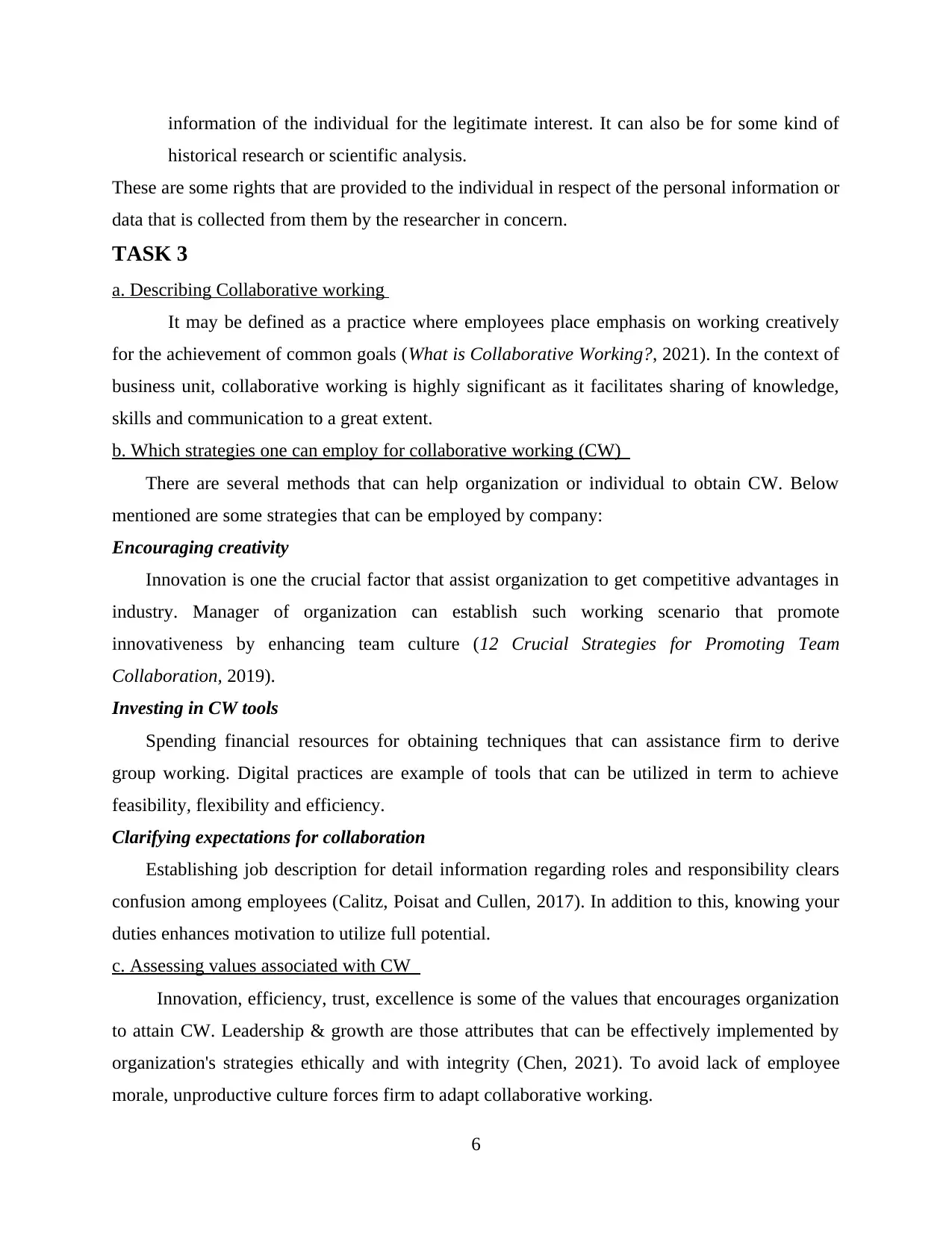
information of the individual for the legitimate interest. It can also be for some kind of
historical research or scientific analysis.
These are some rights that are provided to the individual in respect of the personal information or
data that is collected from them by the researcher in concern.
TASK 3
a. Describing Collaborative working
It may be defined as a practice where employees place emphasis on working creatively
for the achievement of common goals (What is Collaborative Working?, 2021). In the context of
business unit, collaborative working is highly significant as it facilitates sharing of knowledge,
skills and communication to a great extent.
b. Which strategies one can employ for collaborative working (CW)
There are several methods that can help organization or individual to obtain CW. Below
mentioned are some strategies that can be employed by company:
Encouraging creativity
Innovation is one the crucial factor that assist organization to get competitive advantages in
industry. Manager of organization can establish such working scenario that promote
innovativeness by enhancing team culture (12 Crucial Strategies for Promoting Team
Collaboration, 2019).
Investing in CW tools
Spending financial resources for obtaining techniques that can assistance firm to derive
group working. Digital practices are example of tools that can be utilized in term to achieve
feasibility, flexibility and efficiency.
Clarifying expectations for collaboration
Establishing job description for detail information regarding roles and responsibility clears
confusion among employees (Calitz, Poisat and Cullen, 2017). In addition to this, knowing your
duties enhances motivation to utilize full potential.
c. Assessing values associated with CW
Innovation, efficiency, trust, excellence is some of the values that encourages organization
to attain CW. Leadership & growth are those attributes that can be effectively implemented by
organization's strategies ethically and with integrity (Chen, 2021). To avoid lack of employee
morale, unproductive culture forces firm to adapt collaborative working.
6
historical research or scientific analysis.
These are some rights that are provided to the individual in respect of the personal information or
data that is collected from them by the researcher in concern.
TASK 3
a. Describing Collaborative working
It may be defined as a practice where employees place emphasis on working creatively
for the achievement of common goals (What is Collaborative Working?, 2021). In the context of
business unit, collaborative working is highly significant as it facilitates sharing of knowledge,
skills and communication to a great extent.
b. Which strategies one can employ for collaborative working (CW)
There are several methods that can help organization or individual to obtain CW. Below
mentioned are some strategies that can be employed by company:
Encouraging creativity
Innovation is one the crucial factor that assist organization to get competitive advantages in
industry. Manager of organization can establish such working scenario that promote
innovativeness by enhancing team culture (12 Crucial Strategies for Promoting Team
Collaboration, 2019).
Investing in CW tools
Spending financial resources for obtaining techniques that can assistance firm to derive
group working. Digital practices are example of tools that can be utilized in term to achieve
feasibility, flexibility and efficiency.
Clarifying expectations for collaboration
Establishing job description for detail information regarding roles and responsibility clears
confusion among employees (Calitz, Poisat and Cullen, 2017). In addition to this, knowing your
duties enhances motivation to utilize full potential.
c. Assessing values associated with CW
Innovation, efficiency, trust, excellence is some of the values that encourages organization
to attain CW. Leadership & growth are those attributes that can be effectively implemented by
organization's strategies ethically and with integrity (Chen, 2021). To avoid lack of employee
morale, unproductive culture forces firm to adapt collaborative working.
6
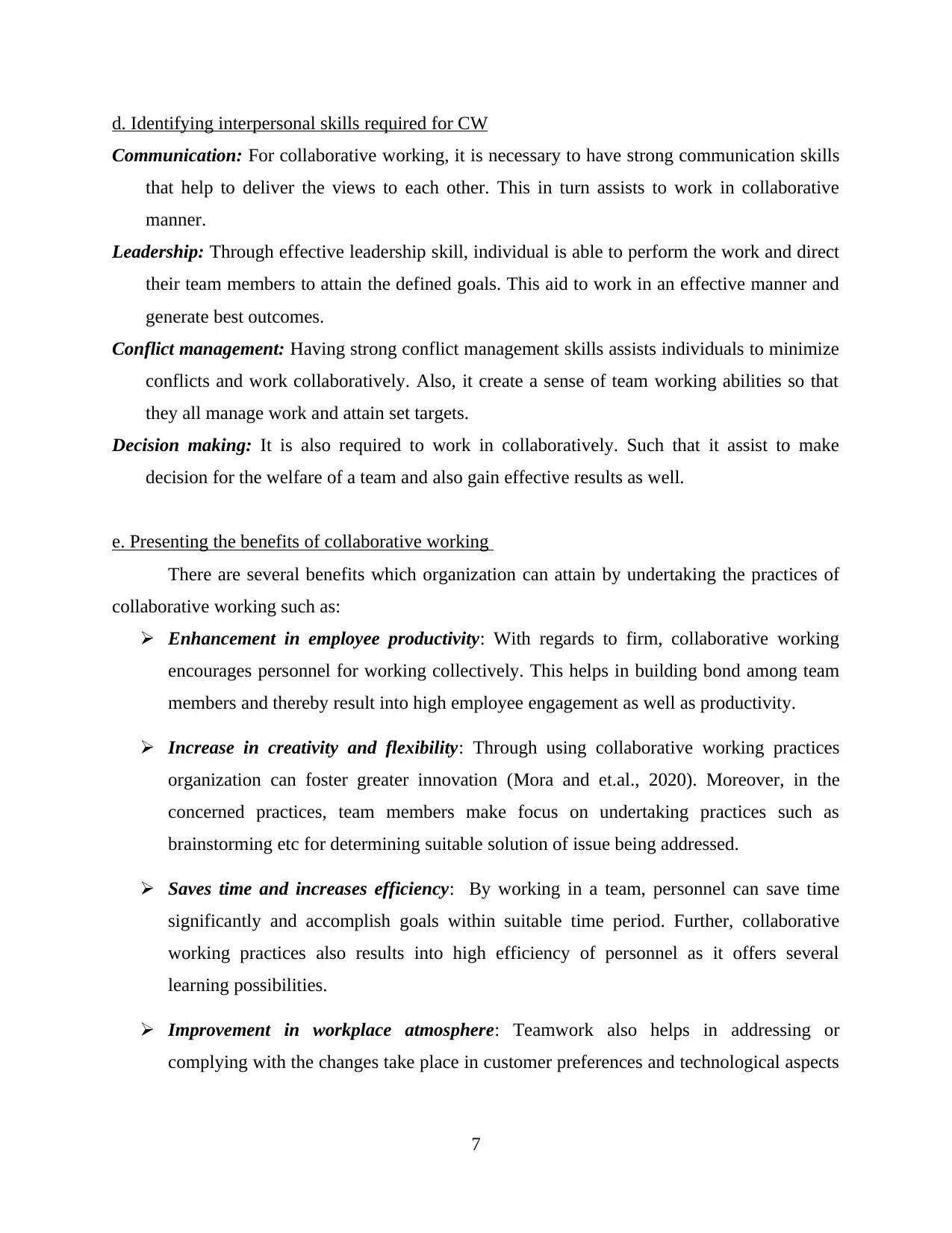
d. Identifying interpersonal skills required for CW
Communication: For collaborative working, it is necessary to have strong communication skills
that help to deliver the views to each other. This in turn assists to work in collaborative
manner.
Leadership: Through effective leadership skill, individual is able to perform the work and direct
their team members to attain the defined goals. This aid to work in an effective manner and
generate best outcomes.
Conflict management: Having strong conflict management skills assists individuals to minimize
conflicts and work collaboratively. Also, it create a sense of team working abilities so that
they all manage work and attain set targets.
Decision making: It is also required to work in collaboratively. Such that it assist to make
decision for the welfare of a team and also gain effective results as well.
e. Presenting the benefits of collaborative working
There are several benefits which organization can attain by undertaking the practices of
collaborative working such as:
Enhancement in employee productivity: With regards to firm, collaborative working
encourages personnel for working collectively. This helps in building bond among team
members and thereby result into high employee engagement as well as productivity.
Increase in creativity and flexibility: Through using collaborative working practices
organization can foster greater innovation (Mora and et.al., 2020). Moreover, in the
concerned practices, team members make focus on undertaking practices such as
brainstorming etc for determining suitable solution of issue being addressed.
Saves time and increases efficiency: By working in a team, personnel can save time
significantly and accomplish goals within suitable time period. Further, collaborative
working practices also results into high efficiency of personnel as it offers several
learning possibilities.
Improvement in workplace atmosphere: Teamwork also helps in addressing or
complying with the changes take place in customer preferences and technological aspects
7
Communication: For collaborative working, it is necessary to have strong communication skills
that help to deliver the views to each other. This in turn assists to work in collaborative
manner.
Leadership: Through effective leadership skill, individual is able to perform the work and direct
their team members to attain the defined goals. This aid to work in an effective manner and
generate best outcomes.
Conflict management: Having strong conflict management skills assists individuals to minimize
conflicts and work collaboratively. Also, it create a sense of team working abilities so that
they all manage work and attain set targets.
Decision making: It is also required to work in collaboratively. Such that it assist to make
decision for the welfare of a team and also gain effective results as well.
e. Presenting the benefits of collaborative working
There are several benefits which organization can attain by undertaking the practices of
collaborative working such as:
Enhancement in employee productivity: With regards to firm, collaborative working
encourages personnel for working collectively. This helps in building bond among team
members and thereby result into high employee engagement as well as productivity.
Increase in creativity and flexibility: Through using collaborative working practices
organization can foster greater innovation (Mora and et.al., 2020). Moreover, in the
concerned practices, team members make focus on undertaking practices such as
brainstorming etc for determining suitable solution of issue being addressed.
Saves time and increases efficiency: By working in a team, personnel can save time
significantly and accomplish goals within suitable time period. Further, collaborative
working practices also results into high efficiency of personnel as it offers several
learning possibilities.
Improvement in workplace atmosphere: Teamwork also helps in addressing or
complying with the changes take place in customer preferences and technological aspects
7
⊘ This is a preview!⊘
Do you want full access?
Subscribe today to unlock all pages.

Trusted by 1+ million students worldwide
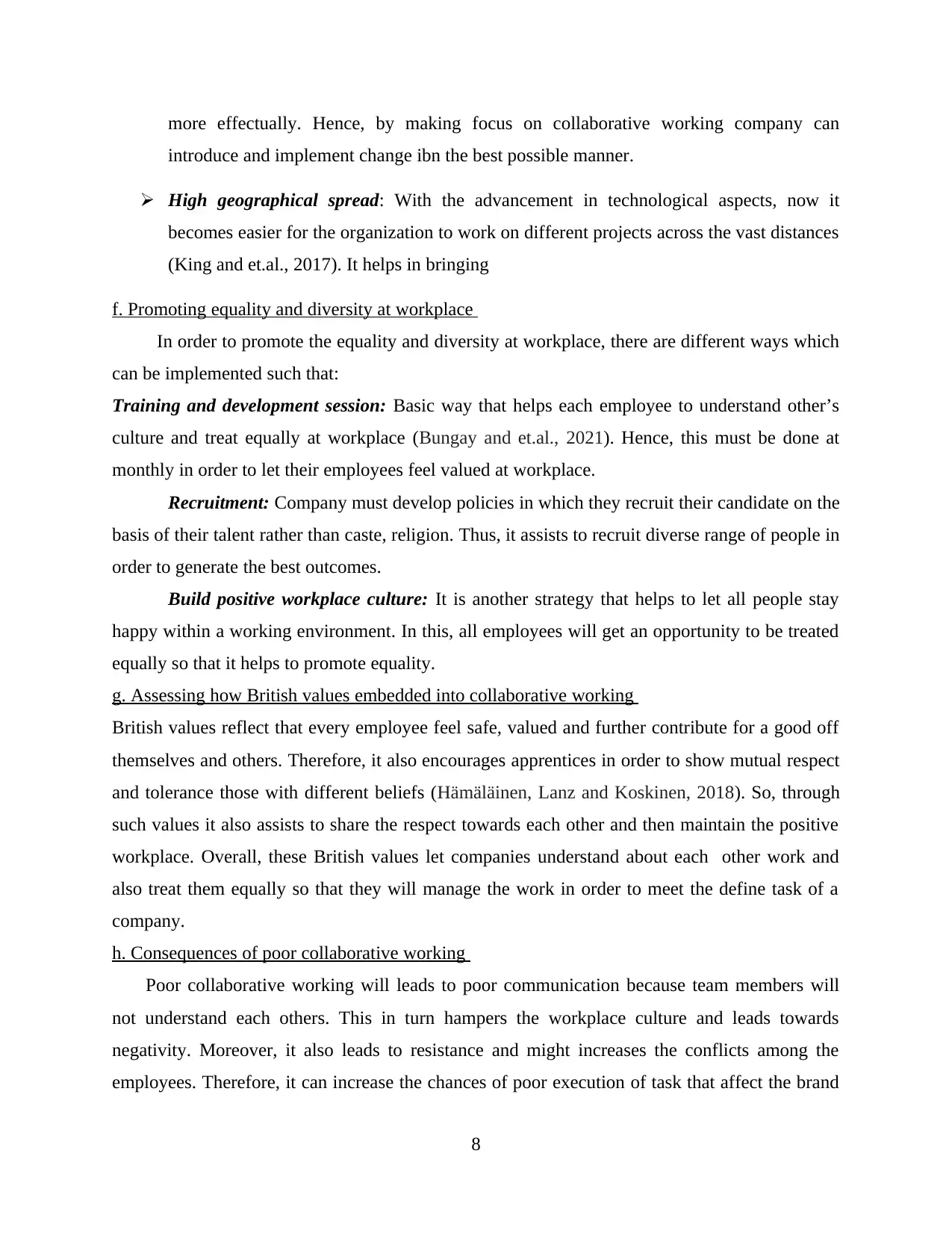
more effectually. Hence, by making focus on collaborative working company can
introduce and implement change ibn the best possible manner.
High geographical spread: With the advancement in technological aspects, now it
becomes easier for the organization to work on different projects across the vast distances
(King and et.al., 2017). It helps in bringing
f. Promoting equality and diversity at workplace
In order to promote the equality and diversity at workplace, there are different ways which
can be implemented such that:
Training and development session: Basic way that helps each employee to understand other’s
culture and treat equally at workplace (Bungay and et.al., 2021). Hence, this must be done at
monthly in order to let their employees feel valued at workplace.
Recruitment: Company must develop policies in which they recruit their candidate on the
basis of their talent rather than caste, religion. Thus, it assists to recruit diverse range of people in
order to generate the best outcomes.
Build positive workplace culture: It is another strategy that helps to let all people stay
happy within a working environment. In this, all employees will get an opportunity to be treated
equally so that it helps to promote equality.
g. Assessing how British values embedded into collaborative working
British values reflect that every employee feel safe, valued and further contribute for a good off
themselves and others. Therefore, it also encourages apprentices in order to show mutual respect
and tolerance those with different beliefs (Hämäläinen, Lanz and Koskinen, 2018). So, through
such values it also assists to share the respect towards each other and then maintain the positive
workplace. Overall, these British values let companies understand about each other work and
also treat them equally so that they will manage the work in order to meet the define task of a
company.
h. Consequences of poor collaborative working
Poor collaborative working will leads to poor communication because team members will
not understand each others. This in turn hampers the workplace culture and leads towards
negativity. Moreover, it also leads to resistance and might increases the conflicts among the
employees. Therefore, it can increase the chances of poor execution of task that affect the brand
8
introduce and implement change ibn the best possible manner.
High geographical spread: With the advancement in technological aspects, now it
becomes easier for the organization to work on different projects across the vast distances
(King and et.al., 2017). It helps in bringing
f. Promoting equality and diversity at workplace
In order to promote the equality and diversity at workplace, there are different ways which
can be implemented such that:
Training and development session: Basic way that helps each employee to understand other’s
culture and treat equally at workplace (Bungay and et.al., 2021). Hence, this must be done at
monthly in order to let their employees feel valued at workplace.
Recruitment: Company must develop policies in which they recruit their candidate on the
basis of their talent rather than caste, religion. Thus, it assists to recruit diverse range of people in
order to generate the best outcomes.
Build positive workplace culture: It is another strategy that helps to let all people stay
happy within a working environment. In this, all employees will get an opportunity to be treated
equally so that it helps to promote equality.
g. Assessing how British values embedded into collaborative working
British values reflect that every employee feel safe, valued and further contribute for a good off
themselves and others. Therefore, it also encourages apprentices in order to show mutual respect
and tolerance those with different beliefs (Hämäläinen, Lanz and Koskinen, 2018). So, through
such values it also assists to share the respect towards each other and then maintain the positive
workplace. Overall, these British values let companies understand about each other work and
also treat them equally so that they will manage the work in order to meet the define task of a
company.
h. Consequences of poor collaborative working
Poor collaborative working will leads to poor communication because team members will
not understand each others. This in turn hampers the workplace culture and leads towards
negativity. Moreover, it also leads to resistance and might increases the conflicts among the
employees. Therefore, it can increase the chances of poor execution of task that affect the brand
8
Paraphrase This Document
Need a fresh take? Get an instant paraphrase of this document with our AI Paraphraser
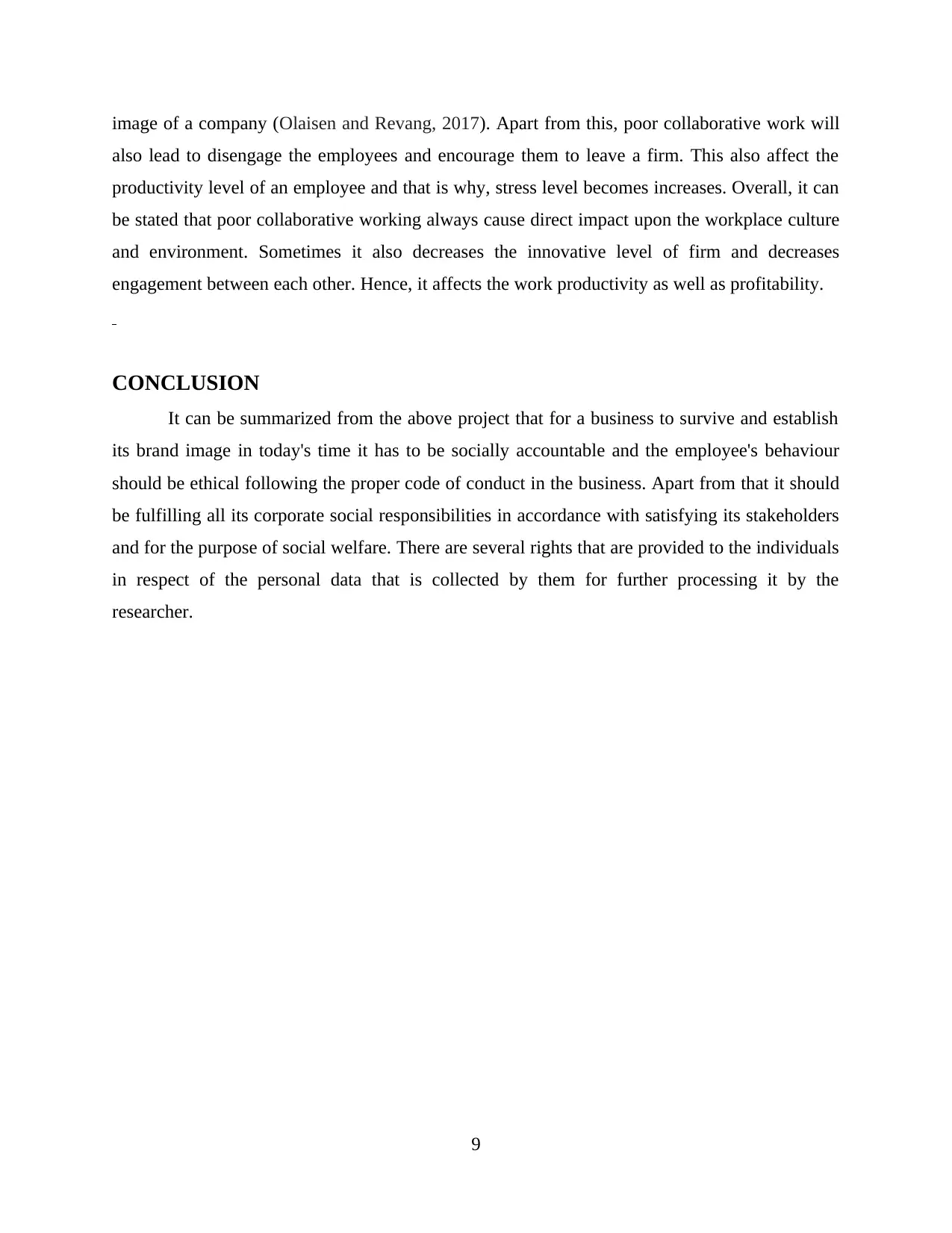
image of a company (Olaisen and Revang, 2017). Apart from this, poor collaborative work will
also lead to disengage the employees and encourage them to leave a firm. This also affect the
productivity level of an employee and that is why, stress level becomes increases. Overall, it can
be stated that poor collaborative working always cause direct impact upon the workplace culture
and environment. Sometimes it also decreases the innovative level of firm and decreases
engagement between each other. Hence, it affects the work productivity as well as profitability.
CONCLUSION
It can be summarized from the above project that for a business to survive and establish
its brand image in today's time it has to be socially accountable and the employee's behaviour
should be ethical following the proper code of conduct in the business. Apart from that it should
be fulfilling all its corporate social responsibilities in accordance with satisfying its stakeholders
and for the purpose of social welfare. There are several rights that are provided to the individuals
in respect of the personal data that is collected by them for further processing it by the
researcher.
9
also lead to disengage the employees and encourage them to leave a firm. This also affect the
productivity level of an employee and that is why, stress level becomes increases. Overall, it can
be stated that poor collaborative working always cause direct impact upon the workplace culture
and environment. Sometimes it also decreases the innovative level of firm and decreases
engagement between each other. Hence, it affects the work productivity as well as profitability.
CONCLUSION
It can be summarized from the above project that for a business to survive and establish
its brand image in today's time it has to be socially accountable and the employee's behaviour
should be ethical following the proper code of conduct in the business. Apart from that it should
be fulfilling all its corporate social responsibilities in accordance with satisfying its stakeholders
and for the purpose of social welfare. There are several rights that are provided to the individuals
in respect of the personal data that is collected by them for further processing it by the
researcher.
9
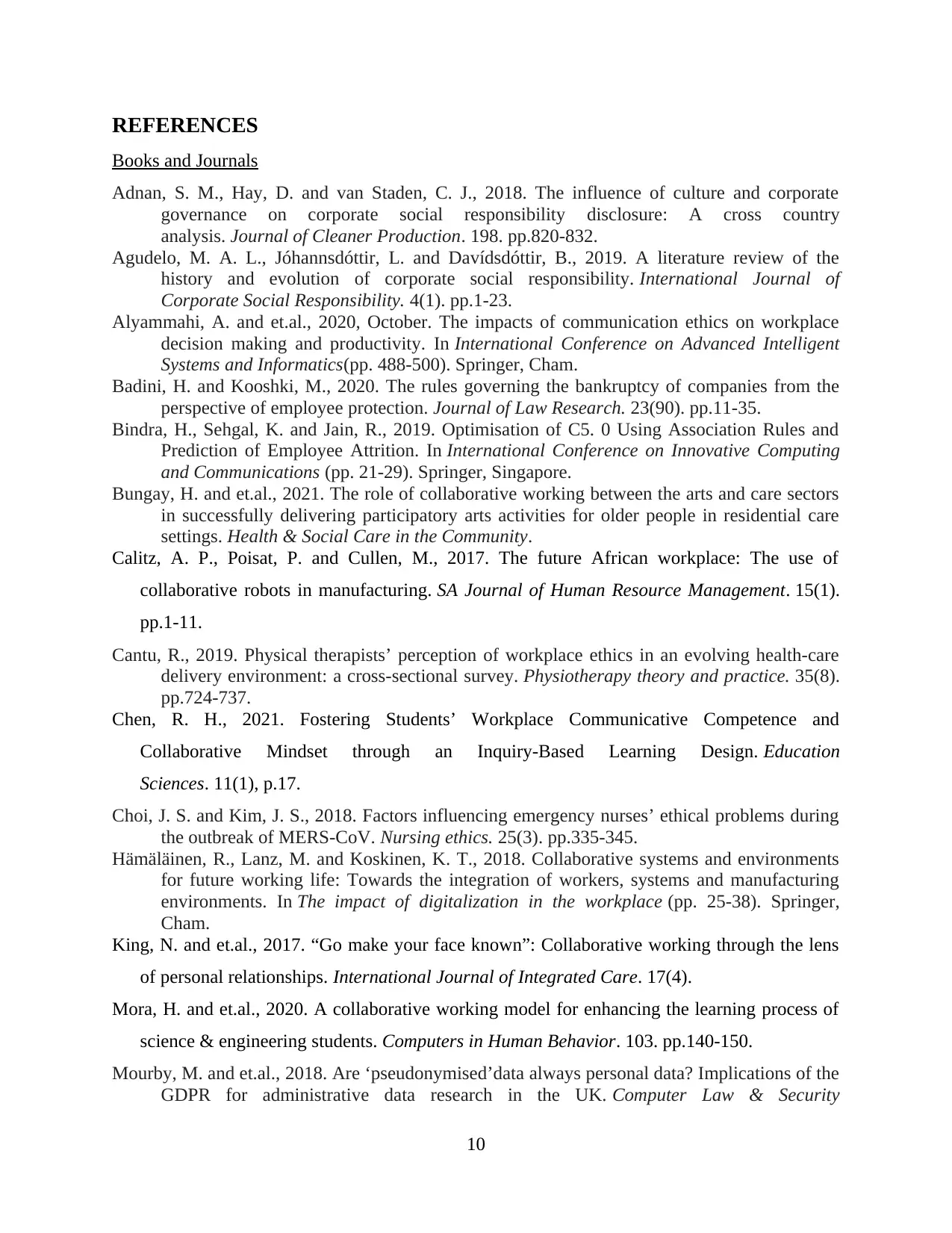
REFERENCES
Books and Journals
Adnan, S. M., Hay, D. and van Staden, C. J., 2018. The influence of culture and corporate
governance on corporate social responsibility disclosure: A cross country
analysis. Journal of Cleaner Production. 198. pp.820-832.
Agudelo, M. A. L., Jóhannsdóttir, L. and Davídsdóttir, B., 2019. A literature review of the
history and evolution of corporate social responsibility. International Journal of
Corporate Social Responsibility. 4(1). pp.1-23.
Alyammahi, A. and et.al., 2020, October. The impacts of communication ethics on workplace
decision making and productivity. In International Conference on Advanced Intelligent
Systems and Informatics(pp. 488-500). Springer, Cham.
Badini, H. and Kooshki, M., 2020. The rules governing the bankruptcy of companies from the
perspective of employee protection. Journal of Law Research. 23(90). pp.11-35.
Bindra, H., Sehgal, K. and Jain, R., 2019. Optimisation of C5. 0 Using Association Rules and
Prediction of Employee Attrition. In International Conference on Innovative Computing
and Communications (pp. 21-29). Springer, Singapore.
Bungay, H. and et.al., 2021. The role of collaborative working between the arts and care sectors
in successfully delivering participatory arts activities for older people in residential care
settings. Health & Social Care in the Community.
Calitz, A. P., Poisat, P. and Cullen, M., 2017. The future African workplace: The use of
collaborative robots in manufacturing. SA Journal of Human Resource Management. 15(1).
pp.1-11.
Cantu, R., 2019. Physical therapists’ perception of workplace ethics in an evolving health-care
delivery environment: a cross-sectional survey. Physiotherapy theory and practice. 35(8).
pp.724-737.
Chen, R. H., 2021. Fostering Students’ Workplace Communicative Competence and
Collaborative Mindset through an Inquiry-Based Learning Design. Education
Sciences. 11(1), p.17.
Choi, J. S. and Kim, J. S., 2018. Factors influencing emergency nurses’ ethical problems during
the outbreak of MERS-CoV. Nursing ethics. 25(3). pp.335-345.
Hämäläinen, R., Lanz, M. and Koskinen, K. T., 2018. Collaborative systems and environments
for future working life: Towards the integration of workers, systems and manufacturing
environments. In The impact of digitalization in the workplace (pp. 25-38). Springer,
Cham.
King, N. and et.al., 2017. “Go make your face known”: Collaborative working through the lens
of personal relationships. International Journal of Integrated Care. 17(4).
Mora, H. and et.al., 2020. A collaborative working model for enhancing the learning process of
science & engineering students. Computers in Human Behavior. 103. pp.140-150.
Mourby, M. and et.al., 2018. Are ‘pseudonymised’data always personal data? Implications of the
GDPR for administrative data research in the UK. Computer Law & Security
10
Books and Journals
Adnan, S. M., Hay, D. and van Staden, C. J., 2018. The influence of culture and corporate
governance on corporate social responsibility disclosure: A cross country
analysis. Journal of Cleaner Production. 198. pp.820-832.
Agudelo, M. A. L., Jóhannsdóttir, L. and Davídsdóttir, B., 2019. A literature review of the
history and evolution of corporate social responsibility. International Journal of
Corporate Social Responsibility. 4(1). pp.1-23.
Alyammahi, A. and et.al., 2020, October. The impacts of communication ethics on workplace
decision making and productivity. In International Conference on Advanced Intelligent
Systems and Informatics(pp. 488-500). Springer, Cham.
Badini, H. and Kooshki, M., 2020. The rules governing the bankruptcy of companies from the
perspective of employee protection. Journal of Law Research. 23(90). pp.11-35.
Bindra, H., Sehgal, K. and Jain, R., 2019. Optimisation of C5. 0 Using Association Rules and
Prediction of Employee Attrition. In International Conference on Innovative Computing
and Communications (pp. 21-29). Springer, Singapore.
Bungay, H. and et.al., 2021. The role of collaborative working between the arts and care sectors
in successfully delivering participatory arts activities for older people in residential care
settings. Health & Social Care in the Community.
Calitz, A. P., Poisat, P. and Cullen, M., 2017. The future African workplace: The use of
collaborative robots in manufacturing. SA Journal of Human Resource Management. 15(1).
pp.1-11.
Cantu, R., 2019. Physical therapists’ perception of workplace ethics in an evolving health-care
delivery environment: a cross-sectional survey. Physiotherapy theory and practice. 35(8).
pp.724-737.
Chen, R. H., 2021. Fostering Students’ Workplace Communicative Competence and
Collaborative Mindset through an Inquiry-Based Learning Design. Education
Sciences. 11(1), p.17.
Choi, J. S. and Kim, J. S., 2018. Factors influencing emergency nurses’ ethical problems during
the outbreak of MERS-CoV. Nursing ethics. 25(3). pp.335-345.
Hämäläinen, R., Lanz, M. and Koskinen, K. T., 2018. Collaborative systems and environments
for future working life: Towards the integration of workers, systems and manufacturing
environments. In The impact of digitalization in the workplace (pp. 25-38). Springer,
Cham.
King, N. and et.al., 2017. “Go make your face known”: Collaborative working through the lens
of personal relationships. International Journal of Integrated Care. 17(4).
Mora, H. and et.al., 2020. A collaborative working model for enhancing the learning process of
science & engineering students. Computers in Human Behavior. 103. pp.140-150.
Mourby, M. and et.al., 2018. Are ‘pseudonymised’data always personal data? Implications of the
GDPR for administrative data research in the UK. Computer Law & Security
10
⊘ This is a preview!⊘
Do you want full access?
Subscribe today to unlock all pages.

Trusted by 1+ million students worldwide
1 out of 13
Related Documents
Your All-in-One AI-Powered Toolkit for Academic Success.
+13062052269
info@desklib.com
Available 24*7 on WhatsApp / Email
![[object Object]](/_next/static/media/star-bottom.7253800d.svg)
Unlock your academic potential
Copyright © 2020–2025 A2Z Services. All Rights Reserved. Developed and managed by ZUCOL.





